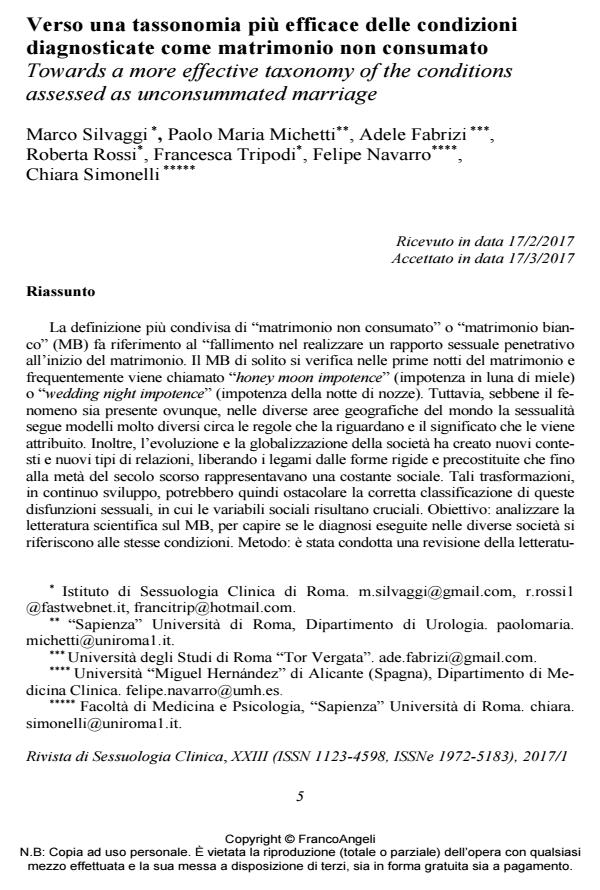Towards a more effective taxonomy of the conditions assessed as unconsummated marriage
Journal title RIVISTA DI SESSUOLOGIA CLINICA
Author/s Marco Silvaggi, Paolo Maria Michetti, Adele Fabrizi, Roberta Rossi, Francesca Tripodi, Felipe Navarro, Chiara Simonelli
Publishing Year 2017 Issue 2017/1
Language Italian Pages 19 P. 5-23 File size 430 KB
DOI 10.3280/RSC2017-001001
DOI is like a bar code for intellectual property: to have more infomation
click here
Below, you can see the article first page
If you want to buy this article in PDF format, you can do it, following the instructions to buy download credits

FrancoAngeli is member of Publishers International Linking Association, Inc (PILA), a not-for-profit association which run the CrossRef service enabling links to and from online scholarly content.
The most shared definition of unconsummated marriage (UM) refers to "the failure to perform successful sexual intercourse at the beginning of the marriage. UM usually occurs in the first few nights of marriage and so it is frequently referred to as "honeymoon impotence" or "wedding night impotence". In the middle-eastern (MES) and western (WS) societies, sexuality follows different patterns in terms of meaning and rules. Moreover, the evolution of societies all around the world created new contexts and kinds of relationship. This could hamper a correct taxonomy of such sexual dysfunction where social variables seems crucial. Aim: To analyze and review data on UM all around the world, to understand if in different societies it refers to the same situation. Method: A review of published literature on UM from 1970 to date, was conducted. Results: Substantial difference emerged from MES to WS. In MES, sexuality is allowable only in marriage, while in WS sexuality and relationship are not strongly linked. This could suggest that the term "marriage" is unable to cover the phenomenon in such different countries. Moreover, the average time before the consultation, causal attribution and prevalence are very different in western and middle eastern countries. Conclusions: We found that the term "first attempts dysfunction" could be better used to describe male, female or both difficulties related to ignorance about sexuality or state/performance anxiety. On the other hand over the individual category of sexual dysfunctions, we suggest a new term as "unconsummated relationship", where individual difficulties toward sexuality are involved creating a couple’s dysfunction.
Keywords: Unconsummated marriage, honeymoon impotence, white marriage, vaginismus, infertility.
Marco Silvaggi, Paolo Maria Michetti, Adele Fabrizi, Roberta Rossi, Francesca Tripodi, Felipe Navarro, Chiara Simonelli, Verso una tassonomia più efficace delle condizioni diagnosticate come matrimonio non consumato in "RIVISTA DI SESSUOLOGIA CLINICA" 1/2017, pp 5-23, DOI: 10.3280/RSC2017-001001